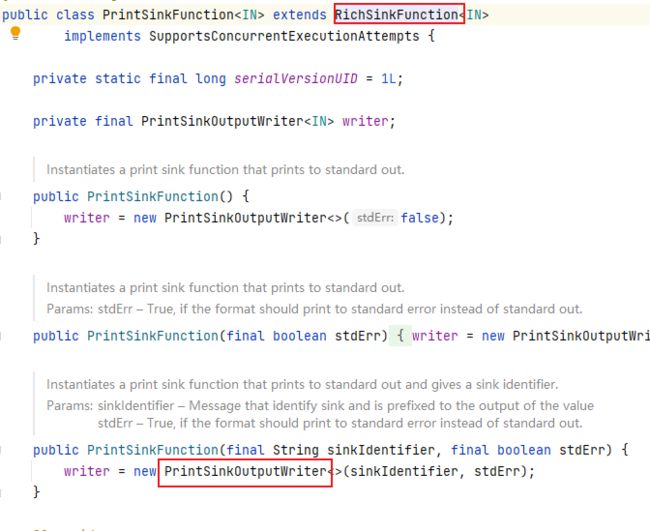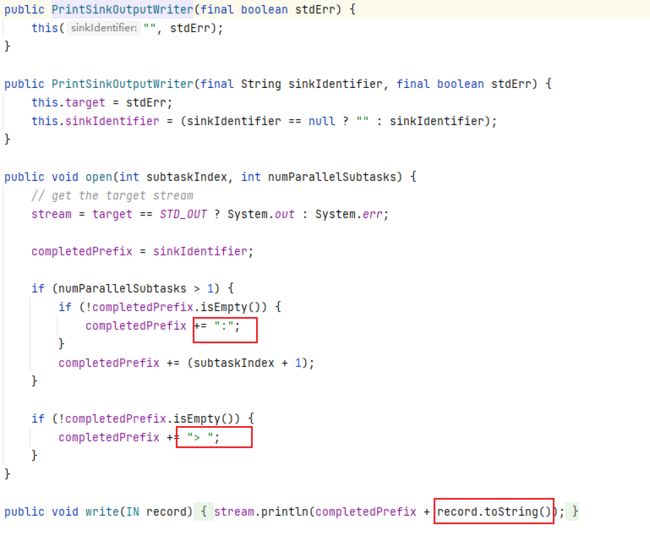Flink从入门到实践(二):Flink DataStream API
文章目录
- 系列文章索引
- 三、DataStream API
-
- 1、官网
- 2、获取执行环境(Environment)
- 3、数据接入(Source)
-
- (1)总览
- (2)代码实例(1.18版本已过时的)
- (3)使用Source接口
- 4、数据处理(Transformation)
-
- (1)总览
- (2)Map(后续用该结果测试)
- (3)Filter
- (4)FlatMap
- (5)KeyBy
- (6)Reduce
- (7)Union
- (8)Connect
- (9)CoMap, CoFlatMap
- (10)Physical Partitioning 分区
- (11)Side Outputs 分流操作
- 5、数据输出(Data Sinks、Connectors)
-
- (1)总览
- (2)print
- (3)自定义Sink打印到控制台
- (4)写入到文件
- (5)输出到MySQL
- (6)输出到Redis
- (7)输出到Socket
- (8)输出到Kafka
系列文章索引
Flink从入门到实践(一):Flink入门、Flink部署
Flink从入门到实践(二):Flink DataStream API
Flink从入门到实践(三):数据实时采集 - Flink MySQL CDC
三、DataStream API
1、官网
https://nightlies.apache.org/flink/flink-docs-release-1.18/docs/dev/datastream/overview/
2、获取执行环境(Environment)
/**
* 1、获取Flink执行的环境
* getExecutionEnvironment() 这是我们用的最多的一种
* createLocalEnvironment() 这种仅限于本地开发使用
* createRemoteEnvironment(String host, int port, String... jarFiles); 知道就行,开发不用
*
*
* getExecutionEnvironment 传入一个 new Configuration(),本质上是一个HashMap
*/
// StreamExecutionEnvironment env = StreamExecutionEnvironment.getExecutionEnvironment(new Configuration());
final StreamExecutionEnvironment env = StreamExecutionEnvironment.getExecutionEnvironment();
env.enableCheckpointing(3000); // 3秒检查一次,提高应用程序的容错性和数据一致性。
DataStream<String> text = env.readTextFile("file:///path/to/file");
通常来说使用getExecutionEnvironment()就可以了,会自动选择你当前的运行环境。
3、数据接入(Source)
(1)总览
我们可以使用env.addSource(sourceFunction)来添加数据来源,实际有许多内置的Source,也可以定义自己的Source。
如果想要自定义数据来源,比如说(该方式在1.18已过时,推荐使用Source接口):
实现SourceFunction接口来实现单并行度的数据来源;
实现ParallelSourceFunction接口来实现多并行度的数据来源;
实现RichParallelSourceFunction接口来实现更高级的多并行度的数据来源。
内置的数据来源(本质上也是使用env.addSource(sourceFunction)来已经预实现了):
env.readTextFile(path):逐行读取文本文件,即符合TextInputFormat规范的文件,并将其作为字符串返回。
readFile(fileInputFormat, path):按照指定的文件输入格式读取(一次)文件。
readFile(fileInputFormat, path, watchType, interval, pathFilter, typeInfo):更加复杂的文件处理。
socketTextStream():从Socket读取。元素可以用分隔符分隔。
fromCollection(Collection)、fromCollection(Iterator, Class)、fromElements(T ...)、fromParallelCollection(SplittableIterator, Class)、generateSequence(from, to):从集合读取。
addSource(new FlinkKafkaConsumer<>(...)):从kafka读取。
(2)代码实例(1.18版本已过时的)
// 实体类
public class Access {
private long time;
private String domain;
private double traffic;
}
public class Student {
private int id;
private String name;
private int age;
}
// 工具类 需要引入mysql-connector-java包
import java.sql.Connection;
import java.sql.DriverManager;
public class MySQLUtils {
public static Connection getConnection() throws Exception {
Class.forName("com.mysql.jdbc.Driver");
return DriverManager.getConnection("jdbc:mysql://localhost:3306/flink", "root", "123");
}
public static void close(AutoCloseable closeable) {
if(null != closeable) {
try {
closeable.close(); // null.close
} catch (Exception e) {
e.printStackTrace();
} finally {
closeable = null;
}
}
}
}
// 自定义source
/**
* 自定义数据源
* 并行度为1
*/
public class AccessSource implements SourceFunction<Access>{
volatile boolean isRunning = true;
/**
* 造数据是自定义数据源的使用方式之一
* @param ctx
* @throws Exception
*/
@Override
public void run(SourceContext<Access> ctx) throws Exception {
Random random = new Random();
String[] domains = {"test1.com","test2.com","test3.com"};
while (isRunning) {
long time = System.currentTimeMillis();
ctx.collect(new Access(time, domains[random.nextInt(domains.length)], random.nextInt(1000) + 1000));
Thread.sleep(2000);
}
}
@Override
public void cancel() {
isRunning = false;
}
}
/**
* 自定义数据源
* 多并行度
*/
public class AccessSourceV2 implements ParallelSourceFunction<Access> {
volatile boolean isRunning = true;
/**
* 造数据是自定义数据源的使用方式之一
* @param ctx
* @throws Exception
*/
@Override
public void run(SourceContext<Access> ctx) throws Exception {
Random random = new Random();
String[] domains = {"test1.com","test2.com","test3.com"};
while (isRunning) {
long time = System.currentTimeMillis();
ctx.collect(new Access(time, domains[random.nextInt(domains.length)], random.nextInt(1000) + 1000));
Thread.sleep(5000);
}
}
@Override
public void cancel() {
isRunning = false;
}
}
/**
* RichSourceFunction: Rich + SourceFunction
* Rich: 包含了生命周期方法 open close
* SourceFunction:单
*
* 自定义二次开发:按照框架(Flink/Spark/....)所提供的接口,去实现自己的业务逻辑即可
* 自定义Source
* 自定义Sink
*
*
* 扩展:对于Spark SQL的外部数据源熟悉吗? 按照Spark所提供的接口,自己实现业务逻辑
*
*/
public class MySQLSource extends RichSourceFunction<Student> {
Connection connection;
PreparedStatement pstmt;
/**
* 初始化操作,建立connection
*/
@Override
public void open(Configuration parameters) throws Exception {
connection = MySQLUtils.getConnection();
pstmt = connection.prepareStatement("select * from student");
}
/**
* 释放资源,关闭connection
*/
@Override
public void close() throws Exception {
MySQLUtils.close(pstmt);
MySQLUtils.close(connection);
}
/**
* 业务逻辑:就是把表中的数据读取出来 ==> Student
*/
@Override
public void run(SourceContext<Student> ctx) throws Exception {
ResultSet rs = pstmt.executeQuery();
while (rs.next()) {
int id = rs.getInt("id");
String name = rs.getString("name");
int age = rs.getInt("age");
Student student = new Student(id, name, age);
ctx.collect(student);
}
}
@Override
public void cancel() {
}
}
/**
* Flink中datasource的使用
*/
public class FlinkDataSourceApp {
public static void main(String[] args) throws Exception {
StreamExecutionEnvironment env = StreamExecutionEnvironment.getExecutionEnvironment();
/**
* 使用内置的dataSource
*/
// DataStreamSource source = env.readFile(new TextInputFormat(null), "data/wc.data");
// // 这个readTextFile方法底层其实调用的就是readFile
// DataStreamSource source = env.readTextFile("data/wc.txt");
// System.out.println(source.getParallelism()); // 8
//
// SingleOutputStreamOperator mapStream = source.map(String::toUpperCase);
// System.out.println(mapStream.getParallelism());
// mapStream.print();
//
// DataStreamSource source = env.fromParallelCollection(new NumberSequenceIterator(1, 10), Long.TYPE);
// System.out.println(source.getParallelism());// 8
// SingleOutputStreamOperator map = source.map(x -> x + 1);
// map.print();
//
// DataStreamSource source = env.addSource(new AccessSourceV2()).setParallelism(3); // 对于ParallelSourceFunction是可以根据具体情况来设定并行度的
// System.out.println(source.getParallelism());
// source.print();
/**
* 使用自定义数据源
*/
// env.addSource(new AccessSource()).print();
// env.addSource(new AccessSourceV2()).setParallelism(3).print(); // 多并行度的可以自行设置并行度
/**
* 使用Flink自定义MySQL的数据源,进而读取MySQL里面的数据
* 该方式已过时 …… flink更新太快了
*/
env.addSource(new MySQLSource()).print();
/**
* 单并行度:fromElements fromCollection socketTextStream
* 多并行度:readTextFile fromParallelCollection generateSequence readFile
* 自定义:
*/
env.execute("作业名字");
}
}
(3)使用Source接口
暂无
4、数据处理(Transformation)
(1)总览
官方文档:
https://nightlies.apache.org/flink/flink-docs-release-1.18/docs/dev/datastream/operators/overview/
运算符将一个或多个数据流转换为新的数据流。程序可以将多种转换组合成复杂的数据流拓扑。
(2)Map(后续用该结果测试)
把DataStream转换成新的DataStream。
// 将读取的文件,按照,分割,然后每一行数据组成一个Access对象
DataStream<Integer> dataStream = env.readTextFile("data/access.log");
SingleOutputStreamOperator<Access> mapStream = dataStream.map(new MapFunction<String, Access>() {
@Override
public Access map(String value) throws Exception {
String[] splits = value.split(",");
Access access = new Access();
access.setTime(Long.parseLong(splits[0].trim()));
access.setDomain(splits[1].trim());
access.setTraffic(Double.parseDouble(splits[2].trim()));
return access;
}
});
mapStream.print();
(3)Filter
把DataStream转换成新的DataStream。
计算每个元素的布尔函数,并保留函数返回true的元素。
也即:过滤出满足条件的元素。
// 过滤出不为0的元素
dataStream.filter(new FilterFunction<Integer>() {
@Override
public boolean filter(Integer value) throws Exception {
return value != 0;
}
});
(4)FlatMap
把DataStream转换成新的DataStream。
可以是一对一、一对多、一对0 一个元素进来,可以出去0、1、多个元素。
dataStream.flatMap(new FlatMapFunction<String, String>() {
@Override
public void flatMap(String value, Collector<String> out)
throws Exception {
for(String word: value.split(" ")){ // 把每一个元素按空格分割
out.collect(word); // 收集每一个 分割后的 元素
}
}
});
(5)KeyBy
把DataStream转换为KeyedStream 。
在逻辑上将流划分为不相交的分区。具有相同关键字的所有记录都被分配到同一个分区。
在内部,keyBy()是通过散列分区实现的。
(类似Map - Reduce思想)
注意!如果是根据一个对象分组,要重写 hashCode()方法,否则会使用默认的Object.hashCode()。
// 根据value的某个属性分组,相当于mysql的group by
// 通常分组之后,就要求和、求一些统计数据了
dataStream.keyBy(value -> value.getSomeKey());
dataStream.keyBy(value -> value.f0);
dataStream
.keyBy(value -> value.getSomeKey())
.sum("field") // 根据字段求和还可以求最大值最小值等
.print();
(6)Reduce
把KeyedStream 转换为 DataStream。
将当前元素与最后一个减少的值合并,并发出新值。
keyedStream.reduce(new ReduceFunction<Integer>() {
@Override
public Integer reduce(Integer value1, Integer value2)
throws Exception {
return value1 + value2;
}
});
(7)Union
把多个DataStream合并为一个DataStream。
两个或多个数据流的联合,创建一个包含所有流中所有元素的新流。注意:如果您将数据流与其自身联合,您将在结果流中两次获得每个元素。
/**
* union:合并多个流
* 数据类型问题:union的多个流中数据类型是需要相同的
* 数据类型相同的多流操作
*/
DataStreamSource<Integer> stream1 = env.fromElements(1, 2, 3);
DataStreamSource<Integer> stream2 = env.fromElements(11, 12, 13);
DataStreamSource<String> stream3 = env.fromElements("A", "B", "C");
stream1.union(stream2).map(x -> "PK_" + x).print();
stream1.union(stream1).print();
stream1.union(stream1, stream2).print();
(8)Connect
把两个DataStream 合并为 ConnectedStream。
DataStream<Integer> someStream = //...
DataStream<String> otherStream = //...
ConnectedStreams<Integer, String> connectedStreams = someStream.connect(otherStream);
/**
* connect: 数据类型可以不同
* 两个流的操作
* 只是形式的连接
*/
ConnectedStreams<Integer, String> connectedStreams = stream1.connect(stream3);
connectedStreams.map(new CoMapFunction<Integer, String, String>() {
// 共享状态
String prefix = "common_";
// 对第一个流的操作
@Override
public String map1(Integer value) throws Exception {
return prefix + value*10;
}
// 对第二个流的操作
@Override
public String map2(String value) throws Exception {
return prefix + value.toLowerCase();
}
}).print();
(9)CoMap, CoFlatMap
将ConnectedStream 转换为 DataStream。
类似于连接数据流上的map和flatMap。
connectedStreams.map(new CoMapFunction<Integer, String, Boolean>() {
@Override
public Boolean map1(Integer value) {
return true;
}
@Override
public Boolean map2(String value) {
return false;
}
});
connectedStreams.flatMap(new CoFlatMapFunction<Integer, String, String>() {
@Override
public void flatMap1(Integer value, Collector<String> out) {
out.collect(value.toString());
}
@Override
public void flatMap2(String value, Collector<String> out) {
for (String word: value.split(" ")) {
out.collect(word);
}
}
});
(10)Physical Partitioning 分区
import org.apache.flink.api.common.functions.MapFunction;
import org.apache.flink.api.common.functions.Partitioner;
import org.apache.flink.api.common.functions.RichMapFunction;
import org.apache.flink.streaming.api.datastream.DataStreamSource;
import org.apache.flink.streaming.api.environment.StreamExecutionEnvironment;
public class PartitionTest2 {
public static void main(String[] args) throws Exception {
StreamExecutionEnvironment env = StreamExecutionEnvironment.getExecutionEnvironment();
env.setParallelism(3); // 一般情况下,并行度跟分区相同,相同分区在同一个线程中执行
DataStreamSource<String> sourcePartition = env.readTextFile("data/access.log");
sourcePartition
// 读取数据转成Access对象
.map(new RichMapFunction<String, Access>() {
@Override
public Access map(String value) throws Exception {
String[] splits = value.split(",");
Access access = new Access();
access.setTime(Long.parseLong(splits[0].trim()));
access.setDomain(splits[1].trim());
access.setTraffic(Double.parseDouble(splits[2].trim()));
return access;
}
})
// 按照指定字段进行分区
.partitionCustom(new Partitioner<String>() {
@Override
public int partition(String key, int numPartitions) {
System.out.println(numPartitions);
if("test1.com".equals(key)) {
return 0;
} else if("test2.com".equals(key)) {
return 1;
} else {
return 2;
}
}
}, x -> x.getDomain())
// 下面的这段map方法目的是验证:相同的域名是否真的在同一个分区内,看threadid是否相同即可
.map(new MapFunction<Access, Access>() {
@Override
public Access map(Access value) throws Exception {
System.out.println("current thread id is " + Thread.currentThread().getId() + ", value is:" + value);
return value;
}
}).print();
env.execute("作业名字");
}
}
(11)Side Outputs 分流操作
https://nightlies.apache.org/flink/flink-docs-release-1.18/docs/dev/datastream/side_output/
/**
* 分流操作:把一个分拆分成多个流
*
* split 在老的flink版本中是有的,但是新的版本中已经没有这个api
*
* 那就说明新版本肯定提供了更好用的使用方式:side output
*/
DataStreamSource<String> source = env.readTextFile("data/access.log");
SingleOutputStreamOperator<Access> stream = source.map(new AccessConvertFunction());
// 很low的写法
// SingleOutputStreamOperator pk1Stream = stream.filter(x -> "test1.com".equals(x.getDomain()));
// SingleOutputStreamOperator pk2Stream = stream.filter(x -> "test1.com".equals(x.getDomain()));
// pk1Stream.print("域名是pk1.com的流");
// pk2Stream.print("域名是pk2.com的流");
// 定义两个Tag
OutputTag<Access> test1OutputTag = new OutputTag<Access>("test1"){};
OutputTag<Access> test2OutputTag = new OutputTag<Access>("test2"){};
SingleOutputStreamOperator<Access> processStream = stream.process(new ProcessFunction<Access, Access>() {
@Override
public void processElement(Access value, Context ctx, Collector<Access> out) throws Exception {
if ("test1.com".equals(value.getDomain())) {
ctx.output(test1OutputTag, value); // pk1.com的走pk1的OutputTag
} else if ("test2.com".equals(value.getDomain())) {
ctx.output(test2OutputTag, value); // pk2.com的走pk2的OutputTag
} else {
out.collect(value); // pk3.com的走主流
}
}
});
processStream.print("主流:");
processStream.getSideOutput(test1OutputTag).print("test1的:");
processStream.getSideOutput(test2OutputTag).print("test2的:");
env.execute("作业名字");
5、数据输出(Data Sinks、Connectors)
(1)总览
https://nightlies.apache.org/flink/flink-docs-release-1.18/docs/dev/datastream/overview/#data-sinks
https://nightlies.apache.org/flink/flink-docs-release-1.18/docs/connectors/datastream/overview/
数据接收器消费数据流,并将它们转发到文件、Socket、外部系统或打印它们。
Flink自带多种内置输出格式:
writeAsText() / TextOutputFormat:将元素作为字符串逐行写入。字符串是通过调用每个元素的toString()方法获得的。
writeAsCsv(...) / CsvOutputFormat:将元组写入逗号分隔值文件。行和字段分隔符是可配置的。每个字段的值来自对象的toString()方法。
print() / printToErr():打印标准输出/标准错误流中每个元素的toString()值。可选地,可以提供一个前缀(msg),将其附加到输出的前面。这有助于区分不同的打印调用。如果并行度大于1,输出还将加上产生输出的任务的标识符。
writeUsingOutputFormat() / FileOutputFormat:自定义文件输出的方法和基类。支持自定义对象到字节的转换。
writeToSocket:根据SerializationSchema将元素写入Socket。
addSink:调用自定义接收器函数。Flink与其他系统(如Apache Kafka)的连接器捆绑在一起,这些连接器被实现为sink函数。
(2)print
stream.print();
/*
>7> Access{time=202810110120, domain='test1.com', traffic=2000.0}
1> Access{time=202810110120, domain='test2.com', traffic=4000.0}
11> Access{time=202810110120, domain='test1.com', traffic=5000.0}
4> Access{time=202810110120, domain='test3.com', traffic=1000.0}
9> Access{time=202810110120, domain='test2.com', traffic=6000.0}
线程号 + 数据.toString()
如果这样:
stream.print().setParallelism(1);
并行度设置为1,那么前面就不会输出数字
这样打印红色:
stream.printToErr();
*/
(3)自定义Sink打印到控制台
stream.addSink(new RichSinkFunction<Access>() {
int subTaskId;
// num>
@Override
public void open(Configuration parameters) throws Exception {
super.open(parameters);
subTaskId = getRuntimeContext().getIndexOfThisSubtask();
}
@Override
public void invoke(Access value, SinkFunction.Context context) throws Exception {
System.out.println(subTaskId + 1 + "> " + value); // 最终执行的方法,输出到终端
}
});
(4)写入到文件
// 已过时
// 写入到文件,每一个并行度,会生成一个文件。并行度为1会生成test一个文件
stream.writeAsText("out/test", FileSystem.WriteMode.OVERWRITE).setParallelism(1);
// 也已经过时了,推荐使用 org.apache.flink.connector.file.sink.FileSink,需要额外引入包
StreamingFileSink<String> fileSink = StreamingFileSink
.forRowFormat(new Path("out"), new SimpleStringEncoder())
.withRollingPolicy(DefaultRollingPolicy.builder() // 构建文本滚动生成的策略
.withRolloverInterval(Duration.ofMinutes(15)) // 按时间间隔滚动
.withInactivityInterval(Duration.ofSeconds(5)) // 按不活跃滚动
.withMaxPartSize(MemorySize.ofMebiBytes(1)) // 按大小滚动
.build())
.build();
// 数据类型需要前后对应
stream.map(Access::toString).addSink(fileSink);
(5)输出到MySQL
JdbcSink.sink提供至少一次保证。然而有效的是,通过创建upsert SQL语句或幂等SQL更新可以实现“恰好一次”。
<dependency>
<groupId>org.apache.flinkgroupId>
<artifactId>flink-connector-jdbcartifactId>
<version>3.1.1-1.17version>
dependency>
// 写入到mysql
// 需要使用upsert语句
SinkFunction<Access> jdbcSink = JdbcSink.sink(
// sql
"insert into access (id, name) values (?, ?) on duplicate key update name=VALUES(name)",
// sql的参数
(JdbcStatementBuilder<Access>) (preparedStatement, access) -> {
preparedStatement.setInt(1, (int)access.getTraffic());
preparedStatement.setString(2, access.getDomain());
},
// 执行参数
JdbcExecutionOptions.builder()
.withBatchSize(5)
.withBatchIntervalMs(200)
.withMaxRetries(5) // 重试
.build(),
// jdbc连接信息
new JdbcConnectionOptions.JdbcConnectionOptionsBuilder()
.withUrl("jdbc:mysql://192.168.56.10:3306/testdb")
.withDriverName("com.mysql.jdbc.Driver")
.withUsername("root")
.withPassword("root")
.build()
);
stream.addSink(jdbcSink);
自1.13起, Flink JDBC sink支持恰好一次模式。该实现依赖于XA标准的JDBC驱动程序支持。如果数据库也支持XA,则大多数驱动程序都支持XA(因此驱动程序通常是相同的)。
StreamExecutionEnvironment env = StreamExecutionEnvironment.getExecutionEnvironment();
env
.fromElements(...)
.addSink(JdbcSink.exactlyOnceSink(
"insert into books (id, title, author, price, qty) values (?,?,?,?,?)",
(ps, t) -> {
ps.setInt(1, t.id);
ps.setString(2, t.title);
ps.setString(3, t.author);
ps.setDouble(4, t.price);
ps.setInt(5, t.qty);
},
JdbcExecutionOptions.builder()
.withMaxRetries(0)
.build(),
JdbcExactlyOnceOptions.defaults(),
() -> {
// create a driver-specific XA DataSource
// The following example is for derby
EmbeddedXADataSource ds = new EmbeddedXADataSource();
ds.setDatabaseName("my_db");
return ds;
});
env.execute();
(6)输出到Redis
https://bahir.apache.org/docs/flink/current/flink-streaming-redis/
public static class RedisExampleMapper implements RedisMapper<Tuple2<String, String>>{
@Override
public RedisCommandDescription getCommandDescription() {
return new RedisCommandDescription(RedisCommand.HSET, "HASH_NAME");
}
@Override
public String getKeyFromData(Tuple2<String, String> data) {
return data.f0;
}
@Override
public String getValueFromData(Tuple2<String, String> data) {
return data.f1;
}
}
FlinkJedisPoolConfig conf = new FlinkJedisPoolConfig.Builder().setHost("127.0.0.1").build();
DataStream<String> stream = ...;
stream.addSink(new RedisSink<Tuple2<String, String>>(conf, new RedisExampleMapper());
(7)输出到Socket
// 输出到Socket,注意类型匹配,输出为字符串
stream.map(Access::toString).writeToSocket("localhost", 9528, new SimpleStringSchema());
(8)输出到Kafka
https://nightlies.apache.org/flink/flink-docs-release-1.18/docs/connectors/datastream/kafka/



